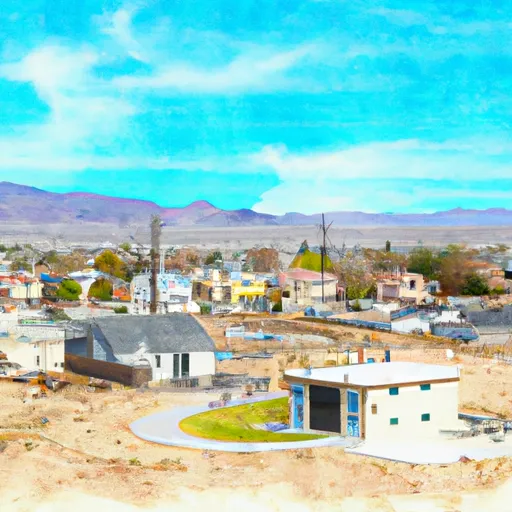-
 Snoflo Premium
Snoflo Premium
Get unlimited access to all our content
With no Ad interruptions! - Start Your Free Trial Login with existing account
Keeler
Eden Index
Climate
8.1
•
Recreation
3.5
•
Community
•
Safeguard
4.5/10

Keeler, California is a small town located in Inyo County, situated on the eastern slopes of the Sierra Nevada Mountains. The climate in Keeler can be described as a high desert climate, with hot and dry summers and mild winters. Temperatures often reach the triple digits during the summer months, while winter temperatures range from the 30s to 50s.
Keeler is located near the Owens Lake, which is an important hydrology constituent of the area. Owens Lake was once a large body of water but has since been mostly drained, resulting in a dry lakebed. However, the lake has become an important habitat for migratory birds, making it a popular spot for birdwatching.
In terms of outdoor recreation opportunities, Keeler is surrounded by stunning natural beauty. It is located near Death Valley National Park, a vast desert park with diverse landscapes, including salt flats, sand dunes, and canyons. Outdoor enthusiasts can enjoy activities such as hiking, camping, and stargazing in the park. Additionally, the nearby Sierra Nevada Mountains offer opportunities for backpacking, fishing, and rock climbing. Overall, Keeler provides a gateway to various outdoor adventures in the surrounding wilderness.
What is the Eden Index?
The Snoflo Eden Index serves as a comprehensive rating system for regions, evaluating their desirability through a holistic assessment of climate health, outdoor recreation opportunities, and natural disaster risk, acknowledging the profound impact of these factors on livability and well-being.
Climate Health Indicator (CHI): 8.1
Keeler receives approximately
146mm of rain per year,
with humidity levels near 36%
and air temperatures averaging around
16°C.
Keeler has a plant hardyness factor of
8, meaning
plants and agriculture in this region tend to thrive here all year round.
By considering the ideal temperature range, reliable water supplies, clean air, and stable seasonal rain or snowpacks, the Climate Health Indicator (CHI) underscores the significance of a healthy climate as the foundation for quality living.
A healthy climate is paramount for ensuring a high quality of life and livability in a region, fostering both physical well-being and environmental harmony. This can be characterized by ideal temperatures, reliable access to water supplies, clean air, and consistent seasonal rain or snowpacks.
Weather Forecast
Streamflow Conditions
Mono-Owens Lakes
Area Rivers
Mono-Owens Lakes
Snowpack Depths
Mono-Owens Lakes
Reservoir Storage Capacity
Mono-Owens Lakes
Groundwater Levels
Recreational Opportunity Index (ROI): 3.5
The Recreational Opportunity Index (ROI) recognizes the value of outdoor recreational options, such as parks, hiking trails, camping sites, and fishing spots, while acknowledging that climate plays a pivotal role in ensuring the comfort and consistency of these experiences.
Access to outdoor recreational opportunities, encompassing activities such as parks, hiking, camping, and fishing, is crucial for overall well-being, and the climate plays a pivotal role in enabling and enhancing these experiences, ensuring that individuals can engage in nature-based activities comfortably and consistently.
Camping Areas
| Campground | Campsites | Reservations | Toilets | Showers | Elevation |
|---|---|---|---|---|---|
| Portagee Joe | 15 | 3,780 ft | |||
| Diaz Lake | 200 | 3,683 ft |
Nearby Fishing
Nearby Ski Areas
Catastrophe Safeguard Index (CSI):
The Catastrophe Safeguard Index (CSI) recognizes that natural disaster risk, encompassing floods, fires, hurricanes, and tornadoes, can drastically affect safety and the overall appeal of an area.
The level of natural disaster risk in a region significantly affects safety and the overall livability, with climate change amplifying these risks by potentially increasing the frequency and intensity of events like floods, fires, hurricanes, and tornadoes, thereby posing substantial challenges to community resilience and well-being.
Community Resilience Indicator (CRI):
The Community Resilience Indicator (CRI) recognizes that education, healthcare, and socioeconomics are crucial to the well-being of a region. The CRI acknowledges the profound impact of these elements on residents' overall quality of life. By evaluating educational resources, healthcare accessibility, and economic inclusivity, the index captures the essential aspects that contribute to a thriving community, fostering resident satisfaction, equity, and social cohesion.

